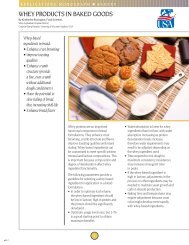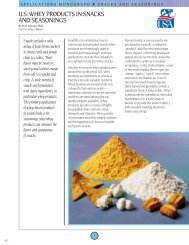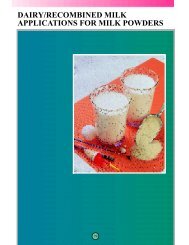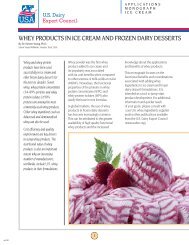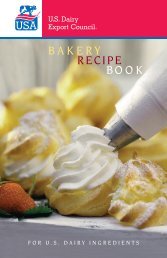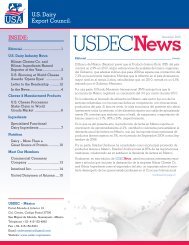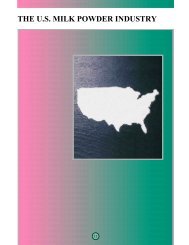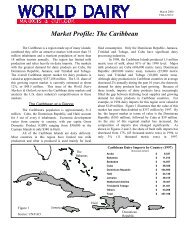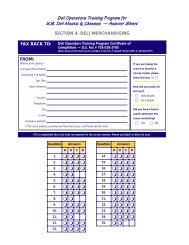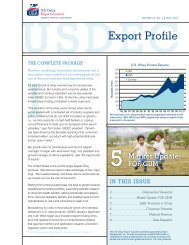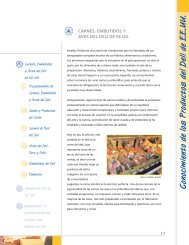REFERENCE MANUAL FOR U.S. WHEY AND LACTOSE PRODUCTS
REFERENCE MANUAL FOR U.S. WHEY AND LACTOSE PRODUCTS
REFERENCE MANUAL FOR U.S. WHEY AND LACTOSE PRODUCTS
- No tags were found...
You also want an ePaper? Increase the reach of your titles
YUMPU automatically turns print PDFs into web optimized ePapers that Google loves.
At the processing facilities, milk movesthrough sanitized pipes, vats and tanks asit is transformed into more than 300 varietiesand styles of cheese, 100 flavors of ice creamand frozen yogurt, 75 flavors and set-typesof yogurt, various milk powder and wheyprotein products, and numerous blends ofbutter and cultured products. Virtually allU.S. dairy processing plants employ qualitymanagement programs, such as HACCP(Hazard Analysis Critical Control Point)or ISO (International Organization forStandardization), to ensure that thefinished products meet the highestattainable standards.The U.S. industry has made continued,large investments in new, state-of-the-artdairy manufacturing facilities. During thepast decade, such developments haveenabled a 45% reduction in the number ofmanufacturing facilities while total outputhas increased by 4% to 5% annually.Continued investment will mean still lowerprocessing costs and higher milk volumes.Employees at these facilities do morethan manufacture dairy products, throughresearch and development laboratoriesthey generate new products and devise newuses for milk and its components. Dairytechnologists and food scientists worktogether to discover how the functionalproperties of milk components can bepreserved or modified by fractionation andother processing procedures. State-of-the-artequipment for drying milk, manufacturingcheese and processing whey has enabled theindustry to create a wide variety of newproducts such as differentiated milk powders,lactose-free cheeses, aseptic milk andlactoferrin. These new products have beendeveloped to meet the expanding globaldemand for highly nutritional dairy productsand ingredients.As trade agreements continue to open globalmarkets, other countries are able to benefitfrom using U.S. dairy products. Additionalinformation on specific whey and lactoseingredients is available from the suppliers ofthe products. The U.S. Dairy Export Councilhas available the names, addresses andphone/fax information for U.S. companiesprocessing and/or marketing each of thetypes of milk powders.This handbook is designed to guide andeducate international product developerson using U.S. whey and lactose ingredients.It is designed as a resource that includes:• A description of the U.S. whey industry.• Definitions of most whey and lactoseproducts.• Descriptions of the processes used toproduce whey and lactose ingredients,and to enhance their nutritional orfunctional properties.• Discussions of the functional andnutritional properties of whey andlactose ingredients.• Applications for these functional,nutritional dairy ingredients.Photo courtesy: Hilmar Cheese CompanyThe U.S. Dairy Export Council recommendsyou always check with your U.S. supplierto obtain detailed product specifications,and that you consult local regulationsregarding ingredient usage and labeling.The formulations in this manual are onlyprovided for demonstration purposesand as a starting point for productdevelopment efforts.Reference Manual for U.S. Whey and Lactose Products7



